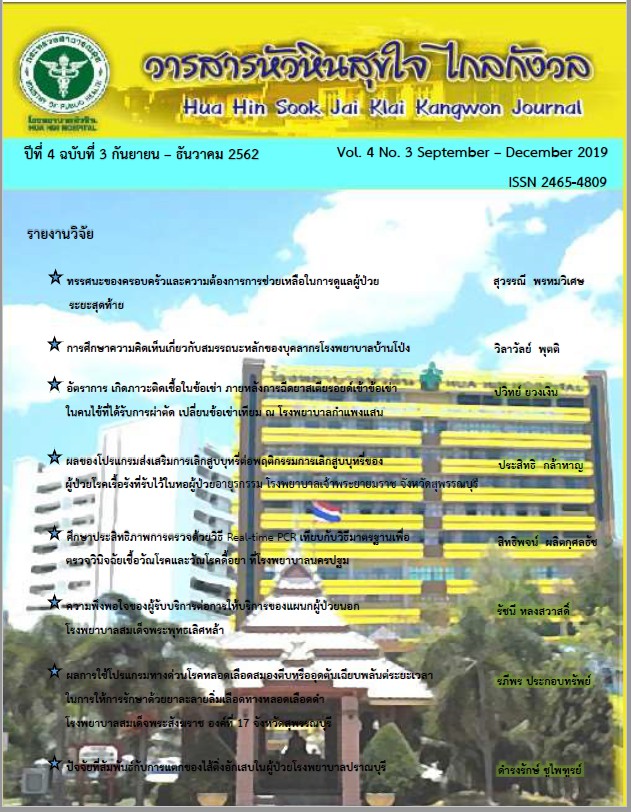The Incidence of Periprosthetic Joint Infection after Intra-articular steroid injection in Total Knee Replacement at Kampaengsan Hospital
Keywords:
Periprosthetic joint infection, Intraarticular steroid injection, Total knee replacementAbstract
Objective: To study the incidence of periprosthetic joint infection after intra-articular steroid injection to cases of total knee replacement in Kampaengsan hospital
Method: This is a Descriptive research. Data were collected from medical records of patients underwent total knee replacement in Kampaengsan hospital from October 2016 to December 2018. The data collected included genders, ages, body mass index (BMI), underlying diseases, the time gap between the last injection and total knee arthroplasty, date of operation and date of last follow up time. The incidence of superficial wound infection and deep space infection according to criteria of Parvizi J et al was identified. Data were analyzed by descriptive statistics.
Result: Of total 70 patients (82 knees), 88.57 % were female, and age ranged 54-78 years (mean = 67 years). The average BMI was 27 kg/m2. The time gap between the last injection and total knee arthroplasty range 35-413 days (mean = 61 days). After follow up time at least 1 year. No incidence of superficial wound infection or deep space infection after Total knee arthroplasty was found.
Conclusion: No incidence of periprosthetic joint infection after intra-articular steroid injection to cases of total knee replacement in Kampaengsan hospital
References
2. K Jordan, N Arden, M Doherty, B Bannwarth, J Bijlsma, P Dieppe et al. EULAR Recommendations 2003: an evidence based approach to the management of knee osteoarthritis: Report of a Task Force of the Standing Committee for International Clinical Studies Including Therapeutic Trials (ESCISIT), Ann Rheum Dis. 2003 Dec; 62(12): 1145–1155.
3. McAlindon TE, Bannuru RR, Sullivan MC, Arden NK, Berenbaum F, Bierma-Zeinstra SM et al. OARSI guidelines for the non-surgical management of knee osteoarthritis. Osteoarthritis Cartilage. 2014 Mar; 22(3):363-88.
4. Peter Jüni, Roman Hari, Anne WS Rutjes, Roland Fischer, Maria G Silletta, Stephan Reichenbach. Intra‐articular corticosteroid for knee osteoarthritis Cochrane Systematic Review ; 2015(10):CD005328.
5. Bannuru RR, Schmid CH, Kent DM, Vaysbrot EE, Wong JB, McAlindon TE. Comparative effectiveness of pharmacologic interventions for knee osteoarthritis: a systematic review and network meta-analysis. Ann Intern Med. 2015; 162(1): 46-54.
6. Tarabichi M, Fleischman AN, Shahi A, Tian S, Parvizi J. Interpretation of Leukocyte Esterase for the Detection of Periprosthetic Joint Infection Based on Serologic Markers. J Arthroplasty. 2017; 32(9S):S97-S100 e1.
7. A. V. PAPAVASILIOU, D. L. ISAAC, R. MARIMUTHU, A. SKYRME, A. ARMITAGE. Infection in knee replacements after previous injection of intra-articular steroid. J Bone Joint Surg [Br] 2006; 88-B:321-3.
8. Aravind Desai, Sreekumar Ramankutty, Tim Board, Videsh Raut. Does intraarticular steroid infiltration increase the rate of infection in subsequent total knee replacements? The Knee.2009; 262–264.
9. Parvizi J, Tan TL, Goswami K, Higuera C, Della Valle C, Chen AF, et al. The 2018 Definition of Periprosthetic Hip and Knee Infection: An Evidence-Based and Validated Criteria. J Arthroplasty. 2018; 33(5):1309-14 e2.
10. Joshy S, Thomas B, Gogi N, Modi A, Singh BK. Effect of intra-articular steroids on deep infections following total knee arthroplasty. Int Orthop. 2006; 30:91–3.
11. Wilson MG, Kelly K, Thornhill TS. Infection as a complication of total knee arthroplasty. Risk factors and treatment in sixty-seven cases. J Bone Jt Surg [Am] 1990; 72(6): 878–83.
12. Yang K, Yeo SJ, Lee BP, Lo NN. Total knee arthroplasty in diabetic patients: a study of 109 consecutive cases. J Arthroplast 2001; 16(1):1–26.
13. Peersman G, Laskin R, Davis J, et al.Infection in total knee replacement: a retrospective review of 6489 total knee replacements. Clini Ortho Relat Res. 2002; 392:15–23.
Downloads
Published
How to Cite
Issue
Section
License
บทความที่ได้รับการตีพิมพ์ในวารสารหัวหินเวชสาร เป็นลิขสิทธิ์ของโรงพยาบาลหัวหิน
บทความที่ลงพิมพ์ใน วารสารหัวหินเวชสาร ถือว่าเป็นความเห็นส่วนตัวของผู้เขียนคณะบรรณาธิการไม่จำเป็นต้องเห็นด้วย ผู้เขียนต้องรับผิดชอบต่อบทความของตนเอง







